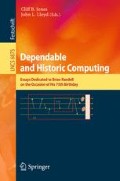Abstract
Atomicity is a fundamental concept in computer science. Initially it was defined as an abstraction to be used in a local context. But over time, its use has expanded or scaled as application programmers have come to rely on it. This reliance is based on atomicity’s ability to make concurrent systems understandable and applications much simpler to program. Atomicity has multiple origins, but it can be fairly said that Brian Randell’s Reliability Project at the University of Newcastle in the 1970’s played a significant early role in defining the atomicity abstraction and building an early prototype to realize it. This paper starts by sketching the Newcastle contribution and goes on to explore how atomicity has been stretched to deal with clusters of processors. The challenge today is to deal well with systems of vast scale, as exemplified by the enormous data centers of current cloud services providers. We sketch a new and promising approach to this challenge.
Access this chapter
Tax calculation will be finalised at checkout
Purchases are for personal use only
Preview
Unable to display preview. Download preview PDF.
References
Amazon: Oracle and AWS, http://aws.amazon.com/solutions/global-solution-providers/oracle/
Agrawal, D., Abbadi, A.E., Das, S.: Big Data and Cloud Computing: New Wine or just New Bottles? In: VLDB (2010), tutorial
Anderson, T., Kerr, R.: Recovery blocks in action: A system supporting high reliability. In: ICSE 1976, pp. 447–457 (1976)
Baker, J., Bond, C., Corbett, J., Furman, J.J., Khorlin, A., Larson, J., Leon, J.-M., Li, Y., Lloyd, A., Yushprakh, V.: Megastore: Providing Scalable, Highly Available Storage for Interactive Services. In: CIDR 2011, pp. 223–234 (2011)
Barga, R.S., Lomet, D.B., Shegalov, G., Weikum, G.: Recovery Guarantees for Internet Applications. ACM Trans. Internet Techn. 4(3), 289–328 (2004)
Bernstein, P., Cseri, I., Dani, N., Ellis, N., Kakivaya, G., Kalhan, A., Lomet, D., Manne, R., Novik, L., Talius, T.: Adapting Microsoft SQL Server for Cloud Computing. In: ICDE 2011, pp. 1255–1263 (2011)
Brewer, E.A.: Towards Robust Distributed Systems Distributed Systems. PODC Keynote (July 19, 2000)
Gray, J., Lorie, R.A., Putzolu, G.R., Traiger, I.L.: Granularity of Locks in a Large Shared Data Base. In: VLDB 1975, pp. 428–451 (1975)
Maurice Herlihy, J., Moss, E.B.: Transactional Memory: Architectural Support for Lock-Free Data Structures. In: ISCA 1993, pp. 289–300 (1993)
Haerder, T., Reuter, A.: Principles of Transaction-Oriented Database Recovery. ACM Computing Surveys 15(4), 287–317 (1983)
Horning, J.J., Lauer, H.C., Melliar-Smith, P.M., Randell, B.: A program structure for error detection and recovery. In: Symposium on Operating Systems 1974, pp. 171–187 (1974)
Jones, C.B., Lomet, D.B., Romanovsky, A.B., Weikum, G.: The Atomic Manifesto. J. UCS 11(5), 636–651 (2005)
Levandoski, J.J., Lomet, D.B., Mokbel, M.F., Zhao, K.: Deuteronomy: Transaction Support for Cloud Data. In: CIDR 2011, pp. 123–133 (2011)
Lomet, D.B.: Process Structuring, Synchronization, and Recovery Using Atomic Actions. In: Language Design for Reliable Software, pp. 128–137 (1977)
Lomet, D.B., Fekete, A., Weikum, G., Zwilling, M.J.: Unbundling Transaction Services in the Cloud. In: CIDR (2009)
Ramakrishnan, R., Cooper, B., Silberstein, A.: Cloud Data Management @ Yahoo! In: Kitagawa, H., Ishikawa, Y., Li, Q., Watanabe, C. (eds.) DASFAA 2010. LNCS, vol. 5981, pp. 2–2. Springer, Heidelberg (2010)
Randell, B.: System Structure for Software Fault Tolerance. IEEE Trans. Software Eng. 1(2), 221–232 (1975)
Tandem Database Group: NonStop SQL, A Distributed, High-Performatlce, High-Availability Implementation of SQL. Tandem Technical Report 87.4 (April 1987)
Author information
Authors and Affiliations
Editor information
Editors and Affiliations
Rights and permissions
Copyright information
© 2011 Springer-Verlag Berlin Heidelberg
About this chapter
Cite this chapter
Lomet, D. (2011). Transactions: From Local Atomicity to Atomicity in the Cloud. In: Jones, C.B., Lloyd, J.L. (eds) Dependable and Historic Computing. Lecture Notes in Computer Science, vol 6875. Springer, Berlin, Heidelberg. https://doi.org/10.1007/978-3-642-24541-1_5
Download citation
DOI: https://doi.org/10.1007/978-3-642-24541-1_5
Publisher Name: Springer, Berlin, Heidelberg
Print ISBN: 978-3-642-24540-4
Online ISBN: 978-3-642-24541-1
eBook Packages: Computer ScienceComputer Science (R0)

